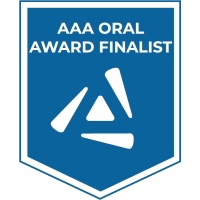Back
ANATOMY
Education
58.1 - Student Approach to Learning and Visuospatial Ability as Independent Predictors of Academic Performance in Human Anatomy
Saturday, April 2, 2022
3:00 PM – 3:15 PM
Room: 103 AB - Pennsylvania Convention Center
Catherine Wang (McGill University), Sean McWatt (McGill University)
-
Catherine Wang
Presenting Author
McGill University
Presenting Author(s)
Several indices have been investigated for their accuracy as predictive metrics of students’ performance in anatomy courses. Both student approaches to learning (SAL) and visuospatial ability (VA) have been shown to be predictive of learning outcome achievement. However, far less anatomy-specific evidence exists for SAL than for VA, and their respective predictive strength has yet to be examined.
The present study investigated the relationship between SAL and VA as predictive metrics for student academic performance, as measured by laboratory-based assessments. In addition, the predictive strength of each metric was evaluated to determine which of the two was most effective at quantitatively assessing anatomy learning environments. It was hypothesized that the variation in grades could be partially explained by both SAL and VA, and that the latter would have a stronger relationship to performance.
Undergraduate students enrolled in an anatomy course at McGill University were surveyed for this study (total n = 138; 76.8% female; average years of age = 19.46, SD = ±1.04). Students were from kinesiology (58.0%), physical therapy (19.6%), occupational therapy (19.6 %), and other (2.9%) programs. In addition to collecting demographic data, the survey included the Revised 2-factor Study Process Questionnaire to collect SAL on deep and surface scales, and the Mental Rotations Test to quantify VA.
A multiple linear regression model was used to assess deep and surface approach to learning scores and VA as covariates that influence grades, while controlling for age, sex, and program of study [F(6,131) = 7.741, P lt; 0.001, adjusted R2 = 0.228]. Data analyses revealed that both VA (β = 0.802, SEM = 0.284; P = 0.006) and deep approach scores (β = 0.776, SEM = 0.246; P = 0.002) had significant positive correlations with grades; however, surface approach scores (β = -0.399, SEM = 0.280; P = 0.157) were not significantly correlated at P ≤ 0.05. Based on the coefficients, a one-point increase on the deep approach scale was slightly more beneficial than the same point-increase on the Mental Rotations Test; however, the advantage was minimal (+0.026%).
These findings assert that SAL and VA can independently predict performance on laboratory-based assessments in human anatomy – with VA representing a personal presage factor, and SAL representing a process factor. A deeper understanding of these metrics allows for better quantitative assessment of success when implementing curricular changes intended to improve anatomy learning environments. Therefore, both metrics should be used for a more comprehensive approach to evaluating educational interventions in anatomy.
The present study investigated the relationship between SAL and VA as predictive metrics for student academic performance, as measured by laboratory-based assessments. In addition, the predictive strength of each metric was evaluated to determine which of the two was most effective at quantitatively assessing anatomy learning environments. It was hypothesized that the variation in grades could be partially explained by both SAL and VA, and that the latter would have a stronger relationship to performance.
Undergraduate students enrolled in an anatomy course at McGill University were surveyed for this study (total n = 138; 76.8% female; average years of age = 19.46, SD = ±1.04). Students were from kinesiology (58.0%), physical therapy (19.6%), occupational therapy (19.6 %), and other (2.9%) programs. In addition to collecting demographic data, the survey included the Revised 2-factor Study Process Questionnaire to collect SAL on deep and surface scales, and the Mental Rotations Test to quantify VA.
A multiple linear regression model was used to assess deep and surface approach to learning scores and VA as covariates that influence grades, while controlling for age, sex, and program of study [F(6,131) = 7.741, P lt; 0.001, adjusted R2 = 0.228]. Data analyses revealed that both VA (β = 0.802, SEM = 0.284; P = 0.006) and deep approach scores (β = 0.776, SEM = 0.246; P = 0.002) had significant positive correlations with grades; however, surface approach scores (β = -0.399, SEM = 0.280; P = 0.157) were not significantly correlated at P ≤ 0.05. Based on the coefficients, a one-point increase on the deep approach scale was slightly more beneficial than the same point-increase on the Mental Rotations Test; however, the advantage was minimal (+0.026%).
These findings assert that SAL and VA can independently predict performance on laboratory-based assessments in human anatomy – with VA representing a personal presage factor, and SAL representing a process factor. A deeper understanding of these metrics allows for better quantitative assessment of success when implementing curricular changes intended to improve anatomy learning environments. Therefore, both metrics should be used for a more comprehensive approach to evaluating educational interventions in anatomy.

